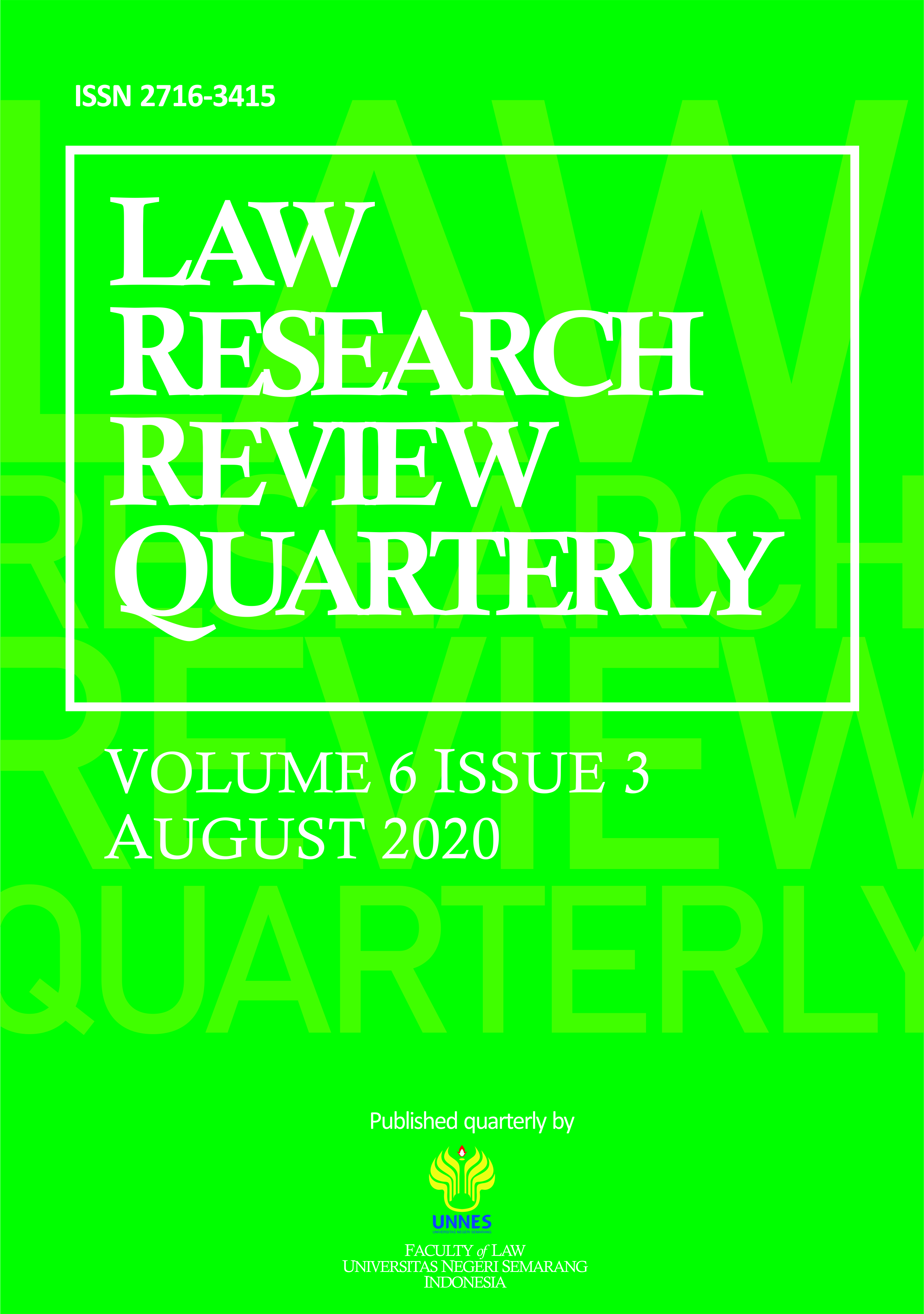Criminological Review of Former Drug Users: What is the Potential of the Evil Characteristics?
Main Article Content
Abstract
One of the efforts to overcome the problem of drug abuse is rehabilitation. In accordance with Article 54 of Law Number 35 of 2009 concerning Narcotics, emphasized that narcotics-addicts and victims of narcotics abuse are obliged to undergo medical rehabilitation and social rehabilitation. This paper tries to examine and analyses how the implementation of drug rehabilitation at the Rumah Damai Foundation, what are the factors that make people fall into drugs, how is the process of drug abuse, what are the causes of drug abuse, and the impact of drug abuse. The subjects of this research consisted of drug abusers who became clients and drug rehabilitation officers as well. Collecting data by interview, observation, and documentation. The data validity used source and method triangulation. Data analysis techniques are data collection, data reduction, data presentation and drawing conclusions. The research highlighted and showed that narcotics or drug abuse is currently very dangerous and has become a problem for the world community, as well as our society. Drugs can be said to be a source of social problems because they have a very bad impact on the continuity of a nation's generation. Apart from external influences there are also internal influences in drug abuse. Based on existing and widely conducted studies, drug abuse by individual drug addicts is indeed influenced by the weak link between individuals and community social control and the existence of an intimate learning process in drug user groups.
Article Details
All writings published in this journal are personal views of the authors and do not represent the views of this journal and the author's affiliated institutions. Author(s) are retain the copyrights of the Article. However, before publishing, it is required to obtain written confirmation from Author(s) in order to ensure the originality (Author Statement of Originality). The statement is to be signed by at least one of the authors who have obtained the assent of the co-author(s) where applicable.This work licensed under a Creative Commons Attribution-ShareAlike 4.0 International (CC BY-SA 4.0)
References
Arief, B. N. (2005). Beberapa Aspek Kebijakan Penegakan dan Pengembangan Hukum Pidana. Bandung: Citra Aditya Bakti.
Amirudin, A., & Asikin, Z. (2012). Pengantar Metode Penelitian Hukum. Jakarta: Raja Grafindo Persada.
Bosu, B. (1982). Sendi Sendi Kriminologi. Surabaya: Usaha Nasional.
BNN. (2019). “Tahap-Tahap Pemilihan Pencandu Narkoba, Online, retrieved from https://rehabilitasi.bnn.go.id/public/articles/read/267.
Chan, G. H., Lo, T. W., Tam, C. H., & Lee, G. K. (2019). Intrinsic motivation and psychological connectedness to drug abuse and rehabilitation: The perspective of self-determination. International journal of environmental research and public health, 16(11), 1934.
Dewi, M. R., Widianingsih, I., & Nurasa, H. (2019, November). Critical Analysis on Entrepreneurial Strategies on Drug Abuse in Indonesia. In International Conference on Democratisation in Southeast Asia (ICDeSA 2019) (pp. 298-300). Atlantis Press.
Fahrizal, Y., Hamid, A., & Daulima, N. (2019, October). Drug Abuse and Relapse Prevention Mechanisms: A Phenomenological Study on The Lived Experiences of Former Drug Users in Yogyakarta Indonesia. In Third International Conference on Sustainable Innovation 2019–Health Science and Nursing (IcoSIHSN 2019) (pp. 107-110). Atlantis Press.
Hadikusuma, H. (1995). Metode Pembuatan Kertas Kerja atau Skripsi Ilmu Hukum, Bandung: Mandar Maju.
Haryadi, R. (2018). Prospek Konseling Komunitas bagi Individu Eks-Pecandu Narkoba (Studi Pada Lembaga Pasca-Rehabilitasi Narkoba Di Kota Semarang). KONSELI: Jurnal Bimbingan dan Konseling (E-Journal), 5(1), 73-84.
Johnson, E. H. (1978). Crime, Correction, and Society: Introduction to Criminology. California. US: Dorsey Press.
Kartono, K. (2009). Patologi Sosial. Jakarta: Rajawali Pers.
Karsono, E. (2004). Mengenai Kecanduan Narkoba. Bandung: Irma Widya.
Kaligis, O. C. (2002). Narkoba dan Peradilannya di Indonesia, Reformasi Hukum Pidana Melalui Perundangan dan Peradilan. Bandung: Alumni.
Lastarya, D. (2006). Narkoba, Perlukah Mengenalnya. Jakarta: Pakarkarya.
Martono, L. H. (2005). Membantu Pemulihan Pecandu Narkoba dan Keluarganya. Jakarta: Balai Pustaka.
Nawawi, J., Sampurno, S., Akub, M. S., & Azisa, N. (2021). Reformulation of Medical Rehabilitation against Victims of Narcotics Abuse in Indonesia. Medico Legal Update, 21(1), 401-405.
Pertiwi, A. A., Saluhiyah, Z., & Indraswari, R. (2020). Peran Teman Sebaya dan Mentor dalam Proses Rehabilitasi di Pusat Rehabilitasi Narkoba Yayasan Rumah Damai Semarang. Jurnal Kesehatan Masyarakat (e-Journal), 8(4), 545-551.
Prasetyo, I. J., Prawiradiredja, S., & Jusnita, R. A. E. (2019). Patterns of Therapeutic Communication in Rehabilitation Institution for the Narcotics Users in East Java, Indonesia. Journal of Drug and Alcohol Research, 8(2), 1-8.
Ramadhan, M., Ariyanti, D. O., & Arifin, R. (2020). Optimization of Legal Education for Drugs Abuse Prevention in Tegalrejo District Yogyakarta. Indonesian Journal of Advocacy and Legal Services, 1(2), 193-204.
Sabarinah, S. (2019). Use of Drug Treatment and Rehabilitation Services in Indonesia: Findings of the 2014 National Narcotic Survey. Asia Pacific Journal of Public Health, 31(6), 548-558.
Santoso, T., Zulfa, E. A. (2001). Kriminologi. Jakarta: Rajawali Pers.
Sonarso, S. (2004). Penegakan Hukum dalam Kajian Sosiologis. Jakarta: Raja Grafindo Persada.
Soekanto, S., Liklikluwata, H., Kusumah, M. W. (1986). Kriminologi, Suatu Pengantar. Jakarta: Ghalia Indonesia.
Soekedy, S. (2002). Menyiram Bara Narkoba. Jakarta: Mapeksi.
Suyatna, U. (2018). Evaluasi Kebijakan Narkotika Pada 34 Provinsi di Indonesia. Sosiohumaniora: Jurnal Ilmu-Ilmu Sosial dan Humaniora, 20(2), 168–176
Suryaman, M. A., Stanislaus, S., & Mabruri, M. I. (2018). Pengaruh religiusitas terhadap resiliensi pada pasien rehabilitasi narkoba yayasan rumah damai semarang. Intuisi: Jurnal Psikologi Ilmiah, 6(2), 98-103.
